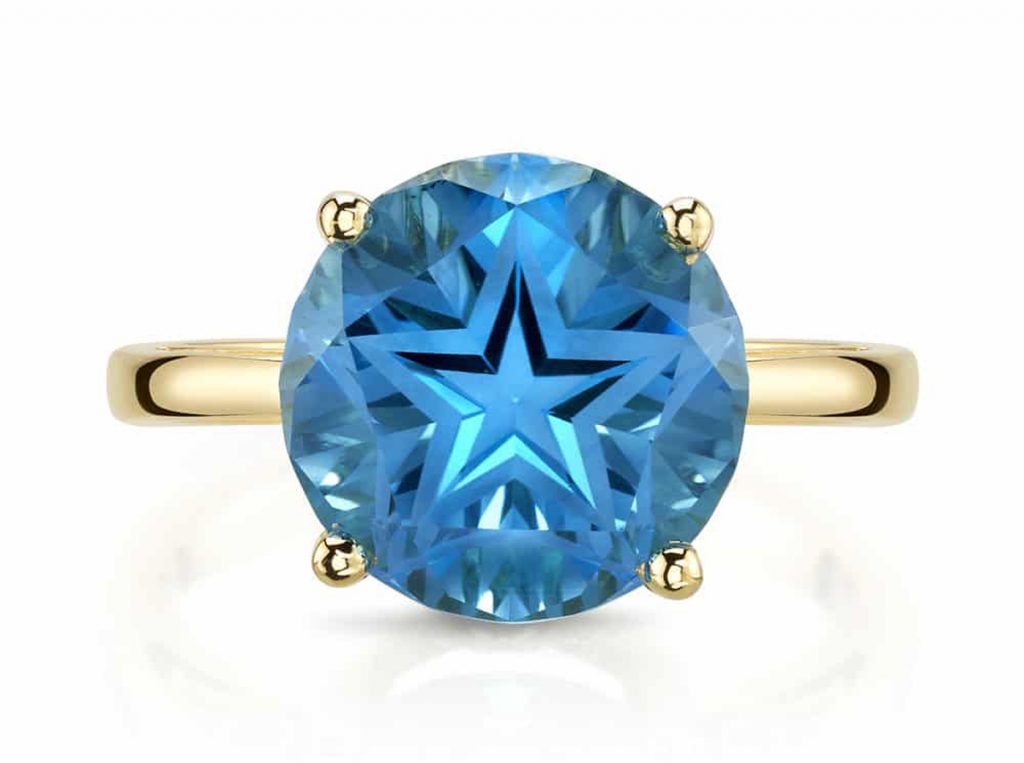Texas’ State Gem, the Blue Topaz

Generally speaking, when you mention the word “topaz” it summons in your mind’s eye a gemstone that’s golden in color, roughly the same hue as fresh honey. This is likely because the yellow topaz is the traditional birthstone for the month of November, and is one of the most common colors of the stone to be found. However, topaz occurs in nature in a variety of colors, and in this article we’re going to focus on the blue topaz. It plays an important role in the state of Texas, and is as beautiful as the Hill Country skies!
Now, the most common color of topaz found in nature is the clear, or white, variety. Sometimes referred to as “true” topaz, this is the purest version of the stone available, without any impurities. Depending on other elements that may be present, a topaz can be anything from crystal clear to dark brown. For example, the traditional yellow topaz gets its color from the presence of iron inside the crystal. Its rarer cousin, the blue topaz, contains traces of chromium or titanium that give it its sparkling blue color.
The first blue topaz stones found in a natural setting were mined in Brazil in the 1960s, and to date the majority of crystals of this color come from the South American country. While a few “outlier” stones have been found in the western United States, they’re only commonly found in this country in one area. One county, to be precise, and it’s right here in the Hill Country! So many jewelry-grade specimens of blue topaz have been found in Mason County that its county seat, Mason, is known as the “Gem of the Hill Country.” Likewise, blue topaz stones are sometimes generically referred to as “Texas Topaz,” regardless of their country of origin.
While its Brazilian cousins can be as deep blue as sapphires, the Texas version of the blue topaz tends to be more pastel in shade, like the waters of a fast-flowing river. The Hill Country blue topaz is very durable, rating an eight on the one-to-ten Mohs Mineral Hardness Scale (with diamonds as a ten, for example). These qualities make it ideal for use in jewelry, and its glittering beauty is best shown off in the “Lone Star Cut,” with the five-pointed Star of Texas in the facets of the stone’s center.
When it came time to designate an official state gemstone, the decision was a simple and popular one for Texas. On March 26, 1969, shortly after its discovery in Mason County, the blue topaz was named the official state gemstone by the Texas State Legislature. By the way, Texas is the only state in the union with an official gemstone cut; in 1977 the Lone Star Cut was given that unique designation.
For several decades, ranchers and other landowners in Mason County would allow “rock hunts” to take place on their property, where tourists could search the earth for sparkling blue topaz keepsakes. However, as gems became more scarce, and digging became more invasive, the practice dwindled over time, until the last hunt-friendly ranch in Mason county discontinued the practice in 2023.
That isn’t to say you won’t find the glittering beauty of blue topaz in the Hill Country! For example, if you check the Texas Hill Country Travel App, you’ll find listings under the “Stores” and “Antiques” categories in over 30 Hill Country towns that carry unique jewelry. The app is a free download, available on both iPhone and Android, and it will direct you to not only Texas blue topaz, but other unique finds and attractions you’ll only find in the Hill Country!
Discover the magic of Texas Hill Country with our Facebook Group! Whether you’ve booked a stay with Backroads Reservations, are planning your next getaway, or simply love this scenic region, our community is for you. Connect with fellow fans and celebrate the stunning beauty of the Hill Country!
